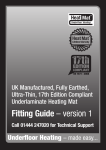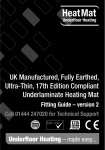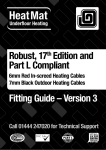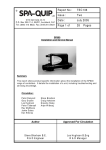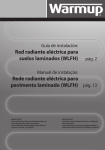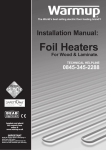Download Warmup WLFH-140W Installation manual
Transcript
Installation Manual: Underlaminate Foil Heater TECHNICAL HELPLINE 0845 345 2288 by filling in your Guarantee information online at warmup.co.uk IMPORTANT Read this manual before attempting to install your foil heater. Incorrect installation could damage the heater and will invalidate your warranty. by filling in your Guarantee information online at warmup.co.uk Contents 3 Getting Started 4 Important! 6 About the Product/ Modifying Your Heating Mats 7 Step 1: Planning Your Installation Step 2: Laying Out Your Foil Heating Mats 9 Step 3: Making the Electrical Connections 13 Installation Examples 16 Standard sizes of foil heating mats and their values NOTICE: This product MUST be used with a dedicated RCD (residual current device) If these instructions are followed you should have no problems. However, if you do require help at any stage, please call our 24hr helpline: Warmup Technical Helpline 0845 345 2288 You can also find a copy of this manual, wiring instructions, a list of frequently asked questions and more helpful information on our website: www.warmup.co.uk 2 Getting Started Before installing your new Warmup® underlaminate foil heating mats, be sure you have the following additional parts: Electrical junction box – used as the connecting junction for the electrical supply cables of the heating mats. Control thermostat – allows you to control the temperature of the room. Residual Current Device - Consult your local dealer regarding the applicable RCD. Hard insulation materials – used as heat insulator under the foil heating mats in installations with concrete subfloors to provide more efficient heating. The material comes in plates, usually made from foamed Polyurethane or Polystyrene and should have Compressive strength of more than 28PSI (2Kg/cm2 ). An example of this is the Warmup® Insulation Board. Soft insulation material – any soft insulation suitable for wood or laminate which has a fire rating of B2 or greater. 3 Important! Please read carefully before installing your Warmup® underlaminate foil heating mats. DON’T: DON’T overlap heating mats. DON’T fold or wrinkle Warmup® Underlaminate foil heating mats. DON’T place heavy/sharp tools (or any other potentially damaging object) on top of the heating mats. DON’T walk unnecessarily on the foil heating mats. DON’T install electrical cables or pipes under the floor with the foil heating mats. DON’T use cellulose insulation. DON’T install mats when the room temperature is below -5ºC. DON’T install foil heating mats anywhere except inside buildings. DON’T install foil mats under walls or partitions,or in areas under heavy cabinets, closets, or fixtures (toilets, sinks, tubs, etc.). DON’T install foil mats within 30mm of any heat conductive building part, such as cold water pipes. DON’T install foil mats within 10mm of one another, 50mm of any wall, or 150mm of a fireplace or hot water pipe. DON’T connect any other electrical appliance on the same electric fused spur or RCD unit of the heating system DON’T install foil heating mats under wooden floor,if the wooden floor is thicker than 18mm DON’T put acoustic material between the foil heating mats and the wooden floor, when installing wooden type floor. DON’T use this heater under any floor covering other than wood or laminate flooring. WARNING Once the foil heating mat has been installed avoid all traffic over the mat until the floor has been laid. Do not install the foil heating mat until the floor is ready to be laid. If the floor is not being laid immediately, all heating mats must be protected with two layers of cardboard or hardboard to prevent damage. Immediately prior to the floor being laid, check it has not been damaged in transit. If you are in any doubt call the Warmup helpline on 0845 345 2288 4 Important! ALWAYS: ALWAYS ensure all earth leads are connected to the earth ring. ALWAYS ensure that the electric circuit that supplies electricity to the Warmup® Underlaminate heating system is equipped with a 30mA residual current device (RCD). ALWAYS connect all cold wire leads from the Warmup® Underlaminate foil heating mats in parallel inside an electrical junction box or boxes. ALWAYS ensure that the total current needed for all mats connected in parallel is not more than 80% of the listed amperage capacity of the electrical junction box and its power supply line and breaker (For advice consult your recommended Part P qualified electrician). ALWAYS provide each room with an Warmup® Underlaminate foil heating system with its own electrical junction box and control thermostat. Each Warmup® thermostat has a maximum capacity of 16 Amps. If the amount of Amps in the room is greater than 16 Amps, divide the amperage over several thermostats. (To calculate the amount of Amps in the room see tables in page 16). ALWAYS use insulation under the mats to reduce running costs and warm-up time. Check with your installer to determine the R value of the sub floor insulation layer. If there is no insulation, or if the R value of the insulation layer is lower than 0.57ft2*h*°F/Btu (0.1m2*°C/W or 1 Tog), please read the insulation instructions on page 6 and act accordingly. ALWAYS ensure that no sharp edges (e.g. metal-edged laminate locking systems) come in contact with the foil heating. As with all electrical projects which are subject to Part P Building Regulations, all electrical work should be carried out by a certified/qualified electrician. All work must conform to BS 7671:1192 and the current IEE Wiring Regulations. 5 About the Product Specifications: Construction: Aluminium foil heater with twin-conductor, having primary of flouropolymer, sandwiched between 2 layers of specially reinforced aluminium foil. Standard Wattage: 80 W/SqM and 140 W/SqM (see page 16 for individual mat specifications) 500mm 50mm 3m Mat Width: Heating cable spacing: Cold lead length: Modifying Your Heating Mats Cutting and turning the mat: Top Aluminium Mat In some instances, you may need to cut and turn the mat to suit the room. It is essential that you do not cut, twist or kink the heating wire. To make a cut, turn the mat over so that the loops are exposed. Lift the wire out of the way when cutting. Once the aluminium foil has been cut and the mat has been repositioned, use the aluminium tape provided to cover the exposed wire and link the two pieces of the mat. 6 Bottom Exposed Wire Cold Lead Step 1: Planning Your Installation Before installing, draw an installation plan showing the placement of the mats, floor sensor, and junction box or boxes. The Warmup® underlaminate foil heating mats should cover at least 80% of the floor area of your room to be used as a primary heat source*. Warmup’s foil heating mats are available in several convenient sizes. Choose the combination of heating mats that best enables you to cover the recommended 80% of your room. Plan to use the larger foil heating mats as much as possible and to use smaller mats only as gap fillers. Note: The mats are supplied with 3 metres of electrical cold leads.If this is not enough, ask your electrician to extend the electrical supply cables. *Depending on insulation, air-flow & overall heat-loss within the room, additional heating may be required. Step 2: Laying Out Your Heating Mats 1 Clean all debris from the floor base. 2 Insert Warmup® Insulation Board 3 Clean all debris from the surface of the grout or insulating material. 4 Roll out heating mats on top of the insulating material. It is recommended to leave a gap of about 50mm from the wall to the heating mats, and a gap of about 10mm between each mat. Ensure that each heating mat is completely flat. Make sure that the cold leads of the mats are on the side of the mat that is closest to the location of the electrical junction box (See step 3 – Making the Electrical Connection). NOTE: When laying two or more heaters, ensure the cold tails reach the thermostat. 7 Step 2: Laying Out Your Heating Mats 1 Power Supply 2 Electrical wire installed in an electric conduit 3 Junction box 1 4 Electrical supply cables 2 5 Foil heating mat 6 Thermostat 7 Floor sensor installed in an electric conduit 8 Floor sensor installed in floor (equal distance between heating foils) 6 7 3 4 5 5 Your mats come with aluminium tape. Stretch the mats and secure the mats to the floor with the tape. Where required, additional duct tape can be used. If any wire has been detached from the foil mat (when mat is cut and turned), that wire MUST be covered by aluminium tape, and bridge the gap between the sections of mat. This is necessary in order to keep the ground circuit intact. 6 Place the electrical supply cables of the mats between the mats toward the junction box. Place the electrical supply cables so that they do not cross each other. Important! Ensure that the electrical supply cables of the mats do not cross over the mats. 8 8 Step 2: Laying Out Your Heating Mats 7 Since the joint is slightly thicker than the rest of the mat, create a slight groove in the insulation board under the joint to ensure that the heating mat lays flat. Create a groove for the cold leads at the point at which they cross. 8 Mark each pair of cold leads coming from the same mat with a number. Place a small sticker with the number of each pair of leads close to the end of the lead. Step 3: Making the Electrical Connections Note: All electrical connections must be performed by a fully qualified and Part P certified electrician. Important! Tightly screw all connections to ensure good electrical contacts. 1 Install the electrical junction box or boxes above floor level according to local safety and building regulations and codes. Place the following label (attached to back cover) on the electrical junction box or boxes indicating that an underfloor heating system is installed in the room. 2 Install the control thermostat as far as possible from any heat sources or heat sinks such as fireplaces, direct sunlight, windows, doors, or anything that could possibly affect proper temperature readings. The suggested placement is 1.5m above floor level. 9 Step 3: Making the Electrical Connections 3 Install an electric conduit to the junction box and thermostat as in the following diagram. 4 Connect the floor temperature safety sensor to the thermostat through a conduit, and install between two heating wire runs on the mat, at least 500mm from the wall. Note: Make sure that the sensor is placed between two runs of wire, at the opposite end from the heating wire loop. The probe wire must not touch or be crossed by the heating element. 5 Measure the resistance of the heating system and record the value. Verify that the values you measure are in line with the resistance value that is printed on the specific mat nameplate. 10 Step 3: Making the Electrical Connections 6 All earth connections from the heaters must be connected to the earth from the power supply of the house. 7 In parallel, feed each mat to the electrical junction box. Make sure that you can see the sticker with the numbers of the leads. If necessary, shorten the leads, but make sure the sticker with the leads' numbers are affixed to the shortened lead. 8 Expose the conductor in each lead. 9 Connect all leads of the same colour. 10 Insert each coloured lead to one connector in the junction box. 11 Connect the same colour cold lead between the thermostat and the connector in the junction box. WARNING: This product MUST be used with a dedicated RCD (residual current device). The RCD should be tested regularly in accordance with the manufacturer's guidelines. 11 Step 3: Making the Electrical Connections 12 Connect the wires to the control thermostat according to the wiring instructions found in the thermostat box. 13 Switch on the foil heating system (see the directions in your thermostat manual)for half an hour to ensure that the system is working properly.It is important to check each entire system to ensure each foil mat is heating. 14 Switch off the heating system (see the directions in your thermostat manual). 15 When the mats are cool,lay down your floor covering. 16 If you are installing a floor covering that uses glue, do not switch on the heating system until the glue is dry. Consult the manufacturer of the material used to determine the amount of drying time needed. 12 Installation Examples Under wood or laminate flooring 1 1 Wood flooring material 2 Heating mat 3 Insulation material 4 Floor slab (wood or concrete) 2 3 4 Hard insulation materials – used as heat insulator under the foil heating mats in installations with concrete subfloors to provide more efficient heating. The material comes in plates, usually made from foamed Polyurethane or Polystyrene and should have Compressive strength of more than 28PSI (2Kg/cm2 ). An example of this is the Warmup® Insulation Board. Soft insulation material – any soft insulation suitable for wood or laminate. which has a fire rating of B2 or greater. 13 NOTES: 14 Standard sizes of foil heating mats and their values 220-240 Volts: Models 80 and 140 watts per m2 Model 16 Area Length Width Total Watts / Total Amps SQM (m) (m) Watts SQM Resistance WLFH-140W/210 1.5 3 0.5 210 140 0.91 251.90 WLFH-140W/280 2 4 0.5 280 140 1.22 188.93 WLFH-140W/420 3 6 0.5 420 140 1.83 125.95 WLFH-140W/560 4 8 0.5 560 140 2.43 94.46 WLFH-140W/700 5 10 0.5 700 140 3.04 75.57 WLFH-140W/840 6 12 0.5 840 140 3.65 62.98 WLFH-140W/980 7 14 0.5 980 140 4.26 53.98 WLFH-140W/1120 8 16 0.5 1120 140 4.87 47.23 WLFH-140W/1260 9 18 0.5 1260 140 5.48 41.98 WLFH-140W/1400 10 20 0.5 1400 140 6.09 37.79 Telephone number Conservatory Hall other Fill in your registration online at www.warmup.co.uk to choose your FREE GIFT. Should you wish to use the form below, a gift will be chosen for you. Name Address Post code E-mail Installer name Date of purchase Bathroom Please state which room the heater(s) is installed: Kitchen Date I hereby confirm that I have read and understand the contents of the Installation Manual, and that the heater has been installed as specified therein. I acknowledge that no claim can be brought against the manufacturer or its agents for any consequential loss or damage whatsoever. I confirm that the heater was working prior to the commencement of tiling. Signed 702 Tudor Estate Abbey Road London NW10 7UW Web: www.warmup.co.uk Email: [email protected] Tel: 0845 345 2288 Fax: 0845 345 2299 The WARMUP word and associated logos are trade marks. © Warmup Plc. 2007 – Regd. TM Nos. 1257724, 4409934, 4409926, 5265707. E & OE. V 0708 ulfh




















